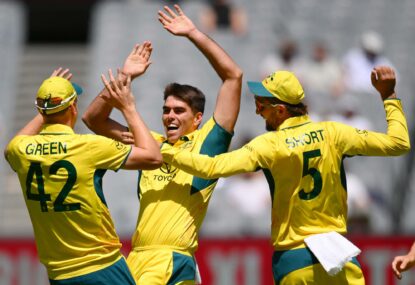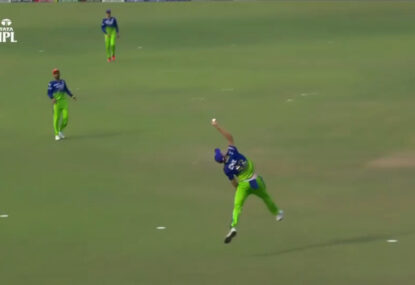Australia play their seventh World Cup semi-final when they take on India at the Sydney Cricket Ground. The winner of this much-awaited encounter will face New Zealand in the final at Melbourne.
The Australians have never lost a semi.
The closest they came to defeat was in 1999, when they sneaked out a famous tie against South Africa to go through.
The semi-final is arguably the toughest game to play in any tournament, and over the years Australia have been fortunate to have players who soaked up the pressure.
Here is a look at the men who delivered and are responsible for Australia’s impressive record.
Gary Gilmour (1975)
Left-arm fast bowler Gilmour was brought in for the semi against hosts England at Headingley after being overlooked in the group stage.
Australian captain Ian Chappell had no hesitation in putting England to bat, and it was not long before Gilmour set the tone.
He began by trapping the dangerous Dennis Amiss plumb in front and followed it by castling Barry Wood with a yorker. The score read 2/11 and this was just the beginning.
Tony Greig became Gilmour’s third victim as he perished to a brilliant catch by Rodney Marsh behind the wicket. Frank Hayes, Keith Fletcher and Alan Knott too did not last long, all of them getting out LBW.
England were reeling at 6/36 with Gilmour bagging all six wickets and none of the batsmen entering double figures. His outstanding figures of 12-6-14-6 was a new ODI record.
England marginally recovered to reach a total of 93, and the English pacemen showed that they were no less effective, destroying the Australian top order to have the Aussies at a worrisome 6/39.
Remarkably, Gilmour was not done. He came out at the fall of the sixth wicket and duly smashed an unbeaten 28 at a run a ball, including five boundaries, to steer Australia to victory. He shared an unbroken 55-run stand with Doug Walters to ensure that there was no further embarrassment.
His performance remains one of the best all-round displays in the World Cup.
Steve Waugh (1987 and 1999)
Allan Border’s Australians faced a challenging semi against Pakistan at Lahore in 1987. After electing to bat, the top order produced a solid effort, with David Boon top-scoring with 65.
At the start of the 50th over, the score was 249/8 – not exactly threatening – and a final push was needed.
Steve Waugh was on strike, and the left-arm pace of an off-colour Saleem Jaffar provided him with the perfect opportunity to finish the innings with a flourish. He started off with a six, then followed it with 4, 2, 2, 0 and 4 to end up with 32* from 28 balls.
This last over of 18 runs was exactly Australia’s victory margin.
Twelve years later, Waugh was captaining Australia and after an indifferent start to the tournament, he managed to squeeze his side into the semis with an unbeaten 120 in the must-win final match of the Super Six round against South Africa at Headingley.
South Africa were Australia’s opponents in the semifinal as well, and Waugh again played a significant role. The South African fast bowlers had Australia on the mat at 4/68, at which stage Waugh was joined by Michael Bevan. The two ice-cool batsmen combined for a confidence-boosting fifth-wicket stand of 90. Waugh scored 56 from 76 balls, which proved to be invaluable.
Of course, his astute captaincy also contributed to South Africa’s downfall.
Craig McDermott (1987)
Pakistan were set 268 to win the semi in front of their home crowd in Lahore, but an in-form Craig McDermott shattered their dreams. The 22-year-old fast bowler removed opener Manzoor Akhtar early, castling him to leave the score at 2/37.
Then at 4/177, Javed Miandad and Wasim Akram were threatening to put Pakistan in charge when McDermott produced another great delivery to uproot Akram’s woodwork.
With the score reading 7/236, Pakistan still had an outside chance of pulling it off. However, McDermott returned to grab the final three wickets, of Saleem Yousuf, Saleem Jaffar and Tauseef Ahmed – all caught behind by Greg Dyer – to ensure an 18-run win for his side with an over left.
He took 5/44, the only five-wicket haul of the tournament.
Michael Bevan (1996 and 1999)
Michael Bevan, one of Australia’s finest limited-overs players, had a big role to play in two successive World Cup semi-finals. Firstly, in 1996, he came out to bat with the score reading a miserable 4/15 against a rampant West Indies pace attack at Mohali.
Bevan along with Stuart Law (72 from 105 balls) proceeded to add a game-changing 138 runs in 32 overs for the fifth wicket. When he was dismissed for a courageous 69 from 110 balls, the score was 171, giving a semblance of respectability to the innings. As it happened, Australia’s modest 8/207 was just enough for victory.
Then in 1999, Bevan put his hand up again in a very similar situation. Coming out to bat at a perilous 4/68 in the epic encounter against South Africa at Edgbaston, and with captain Steve Waugh (56) for company, he set about rebuilding the innings.
His partnership with Waugh realised 90, but following that, Australia lost two quick wickets to be 6/158. Bevan, a master at batting with the lower order, dominated a 49-run seventh-wicket stand with Shane Warne. The remaining four wickets however fell for six runs, with Bevan the last man to fall, for 65 from 101 balls with 6 fours, the highest score of the match.
Shane Warne (1996 and 1999)
Like Bevan, leg-spin wizard Shane Warne was a major catalyst in Australia’s semi-final successes in 1996 and 1999. On both occasions, he was named the man of the match for turning around his team’s fortunes with some magical bowling.
In 1996 against the West Indies at Mohali, Australia had recovered from a disastrous start to post a total of 207. Warne struck early in the chase, catching Courtney Browne off his own bowling to make the score 1/25. However, Browne’s fellow opener Shivnarine Chanderpaul (80) was batting resolutely at the end, and he shared a 68-run second-wicket stand of 68 with Brian Lara.
Chanderpaul and Richie Richardson then added a further 72 for the third wicket, and the West Indians appeared to be cruising to victory. Glenn McGrath provided the opening by removing Chanderpaul and Roger Harper in quick succession, thus setting the stage for Warne.
Warne duly dismissed Ottis Gibson (caught behind), Jimmy Adams and Ian Bishop (both LBW) in a stunning spell from which the Windies could not recover. They were bowled out for 202 in the final over, with Warne recording figures of 4/36.
He came up with an even better performance in the 1999 semi against South Africa at Edgbaston. Chasing Australia’s 213, South African openers Gary Kirsten and Herschelle Gibbs provided a sound start by adding 48 in 12 overs. Warne struck in his second over, bowling Gibbs with a drifting delivery that left the batsman bewildered. He repeated the dose to Kirsten, who attempted to sweep the first ball of his third over which ended up clipping his off-stump.
Two balls later, he had captain Hansie Cronje caught at slip by Mark Waugh. South Africa were now 3/53, and Warne had three wickets in just eight balls. His figures read 3-2-3-3 at this juncture, and he went on to bowl eight overs on the trot in his first spell.
South Africa rebuilt well through Jacques Kallis. When Warne began his final over, South Africa were 5/161 and needed 53 to win from 36 balls. Off the fifth ball, he got rid of Kallis (53) with a flighted delivery which was played to Steve Waugh in the covers.
Warne finished with figures of 10-4-29-4, which went a long way toward the match ending in a thrilling tie.
Andrew Symonds (2003)
Andrew Symonds played the most important innings of his ODI career in the 2003 semifinal against Sri Lanka at Port Elizabeth.
Australia had been unbeaten throughout the tournament, but found themselves in some trouble at 51/3 after electing to bat first. The star trio of Adam Gilchrist, Matthew Hayden and Ricky Ponting were all back in the pavillion and the Sri Lankans had their tails up.
Symonds came out at number five, and along with Darren Lehmann put the innings on back on track. The pair added a measured 93 for the fourth wicket before Lehmann (36) was dismissed.
Symonds reached his 50 from 69 balls with a boundary off Sanath Jayasuriya in the 33rd over. Besides him, no other batsman showed the necessary application on a difficult wicket.
He battled on and remained until the end, scoring an unbeaten 91 from 118 balls, with 7 fours and a six. Thanks to him, Australia’s final total of 7/212 proved to be a tricky one for Sri Lanka, who went down by 48 runs on the Duckworth/Lewis method.
Other notable Australian performers in World Cup semifinals:
David Boon and Mark Veletta (1987): Boon scored 65 from 91 balls, while Veletta scored 48 from 50 balls to pave the way for Australia’s strong total.
Stuart Law (1996): scored a valiant 72 from 105 balls under tremendous pressure to help bail his side out from a precarious position.
Glenn McGrath (1996 and 2007): In 1996 he took two wickets at a key stage of the West Indian innings. In 2007, he bagged 3/18 to rattle South Africa’s top order.
Damien Fleming (1996 and 1999): bowled the final over of both the matches in unbelievably tense situations.
Shaun Tait (2007): bowled a hostile spell of 4/39 to destroy South Africa, resulting in an easy Australian victory.





































































































